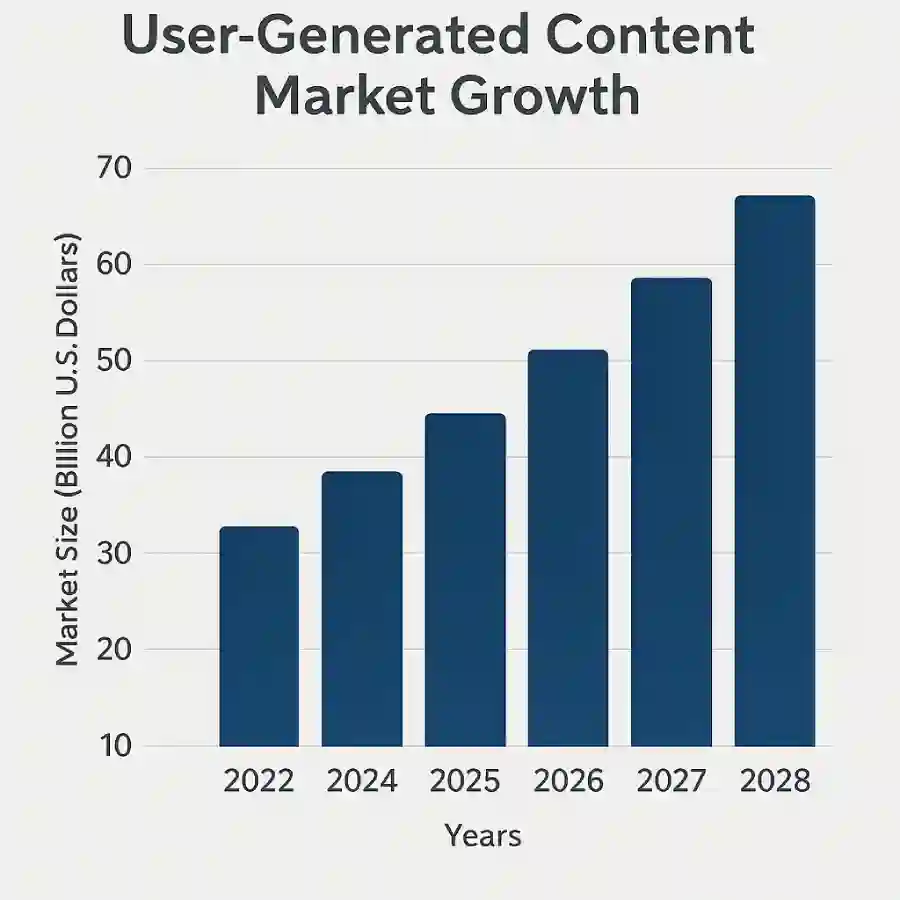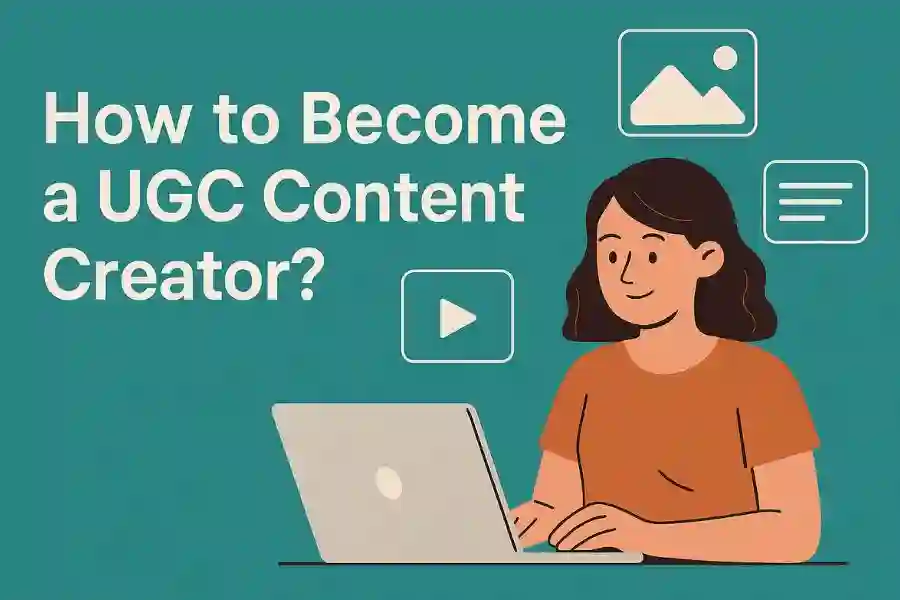User-generated content (UGC) is trust—so much so that it is no longer trending but a strong marketing tool that brands can use for creating realism. With platforms such as TikTok, Instagram, and YouTube turning average individuals into influential creators, hundreds ask, “How do I become a UGC content creator?” If you’ve admired creators who align with brands and make money from relatable, here-I-am ranges, you’re not the only one:
The creator economy is roaring. According to Statista, the global influencer marketing market value stood at $21.1 billion in 2023—a sharp growth from just $1.7 billion in 2016. At the heart of this change are UGC creators: real people having a real range that resonates.
Whether you’re a developing influencer, an aspiring digital marketer, or someone examining a side hustle with revenue potential, becoming a UGC content creator could be your next big action.
Key Takeaways:
- UGC content creators are everyday people who create brand-related content without being influencers.
- You don’t need a huge following; you need creativity, consistency, and strategy.
- The UGC industry is a low-barrier, high-opportunity field with growing brand demand.
- This guide explores the skills, tools, and strategies you need to launch your UGC career.
- Includes pro tips, tools, pricing insights, and platform-specific strategies.
What Is UGC and Why Is It a Big Deal for Brands?
Before getting into how to become a UGC content creator, we must define UGC.
User-generated content (UGC), which includes text, videos, images, and reviews — is any content and not from brands. The material is frequently disseminated on social media sites; corporations use it to market their product or benefits.
“People trust people, not ads. That’s why UGC performs better than traditional marketing.” — Neil Patel, Digital Marketing Expert

Why UGC Works:
- Authenticity: It feels more genuine than scripted ads.
- Engagement: UGC earns higher engagement rates.
- Cost-Effectiveness: Brands save on expensive production.
- Conversion Boost: 79% of consumers say UGC highly impacts their purchasing decisions (Stackla).
Types of UGC:
- Unboxing videos
- Product tutorials
- Review and reaction videos
- Lifestyle photography featuring branded items
UGC creators differ from influencers in that they create content for brands to repurpose, not necessarily to post on their channels. That distinction opens the door for many creators without a massive online following.
Bonus Tip: Use AI-Powered Tools
Incorporate tools like ChatGPT to streamline your content scripting, idea generation, and even basic editing for a quicker turnaround.
How To Become A UGC Content Creator: Starting From Scratch
So, how do you start your journey as a UGC content creator?
Step 1: Understand Your “Why”
Before you shoot your first video or pitch a brand, ask yourself:
- Do I enjoy storytelling and content creation?
- Am I comfortable appearing on camera or narrating content?
- Do I have a niche I resonate with (beauty, tech, fitness)?
Your answers shape your approach and help you build a brand voice that feels natural.
Step 2: Research the Market
Study top-performing UGC creators on TikTok or Instagram. Look for:
- Tone of voice
- Editing style
- Brand collaborations
- Type of content (funny, aesthetic, informative)
Use platforms like:
- TikTok Creator Marketplace
- Instagram Reels Explorer
- Hashtags like #UGCCreator or #UGCContent
Step 3: Set Up Your Creator Kit
You don’t need a pro studio. Here’s a basic UGC starter kit:
| Tool | Purpose |
| Smartphone (iPhone or Android) | Shooting HD content |
| Tripod with ring light | Stable, well-lit videos |
| Editing apps (CapCut, InShot, Adobe Rush) | Post-production magic |
| Google Drive/Dropbox | Store & share with brands |
Pro Tip: Invest in good natural lighting and learn basic video composition.
Step 4: Choose a Niche That Converts
High-demand niches include:
- Skincare & Beauty
- Wellness & Fitness
- Tech & Gadgets
- Home Decor & Organization
- Fashion
Why it matters: Brands in niche markets tend to pay more for content that matches their customer avatar.
Build Your UGC Portfolio: Your Creator Resume
You wouldn’t apply for a job without a resume, right? In the UGC world, your portfolio is your calling card.
What to Include:
- Short intro video: Who you are and what you do
- 3–5 sample videos: Mimic brand campaigns for products you already use
- Niche focus: If you love skincare, create skincare UGC; if you’re into tech, go all-in.
- Voice-over samples: Brands love diverse narration styles
Don’t wait for a paid gig to build content—create mock UGC! Use products from your home and make high-quality content.
Where to Host Your Portfolio:
- Google Drive (with shareable link)
- Notion page or Canva site
- Personal website (Wix, Squarespace)
Portfolio Optimization Tips:
- Use scroll-stopping thumbnails
- Add brief captions under each video explaining context
- Show off diversity in tone, setting, and product type
Make sure everything is downloadable and branded with your creator name and contact details.
Pitching to Brands: Get Noticed (Even Without Followers)
Once your portfolio is ready, it’s time to approach brands.
How to Find UGC-Friendly Brands:
- Look for smaller DTC brands (they have lower budgets but high content needs)
- Use platforms like Billo, Insense, Trend.io, and JoinBrands
- Search #BrandCollab #UGCNeeded on social media
Crafting Your Pitch:
Here’s a basic structure:
Hi [Brand Name],
My name is [Your Name], and I’m a UGC creator who specializes in [niche]. I love what you’re doing with [specific campaign/product]. I’d love to create relatable, scroll-stopping content for your brand that builds trust and drives conversions.
Here’s my portfolio: [Link]
Looking forward to collaborating!
Best,
[Your Name]
Bonus Tip: Automate Your Outreach
Use tools like Notion CRM, Trello, or Airtable to track pitches and responses.
Get Paid: Pricing Your UGC Content Fairly
One of the most frequently asked questions in this field is: “How much should I charge as a UGC creator?”
UGC Pricing Table (Average Rates):
| Content Type | Beginner | Intermediate | Pro |
| 1 UGC Video (30-60s) | $50–$150 | $150–$400 | $500+ |
| 3-Video Bundle | $120–$400 | $400–$1000 | $1200+ |
| Voiceover Only | $30–$100 | $100–$250 | $300+ |
Monetization Tips:
- Include usage rights (organic vs paid ads)
- Add surcharges for exclusivity or expedited delivery
- Offer retainer packages for monthly content
Always use contracts. Platforms like HelloBonsai or Fiverr Workspace can help you draft proposals and invoices.
Tools & Skills to Level Up as a UGC Creator
To stand out, you need more than just a camera.
Must-Have Skills:
- Video editing (transitions, captions, color grading)
- Scriptwriting (hook, value, CTA)
- Storytelling (relatable, emotional narratives)
- Analytics (track performance, iterate on top performers)
Tools to Consider:
- CapCut or VN Video Editor (mobile editing)
- Descript (voiceover editing)
- Canva Pro (graphic assets, thumbnails)
- ChatGPT (script generation & ideation)
- Captions.ai (editing assistant for social content)
Invest in online courses on platforms like Skillshare, Domestika, or Coursera to enhance your skills.
Staying Relevant: Evolve With Trends & Algorithm Shifts
The content landscape changes fast. What worked last month might flop today. To thrive:
- Follow TikTok Creative Center and Instagram for Business for trend reports
- Subscribe to newsletters like Future Social, Creator Economy by Colin & Samir
- Keep experimenting with hooks, formats, and content lengths
Community Is Key
- Join Discord groups, Facebook creator communities
- Collaborate with fellow creators for cross-promotion
- Attend webinars and virtual creator events
FAQs About Becoming a UGC Content Creator
Do I need a large following to become a UGC creator?
No! Brands hire UGC creators for their content, not their audience.
Can I be both a UGC creator and influencer?
Absolutely. Many influencers create UGC content as an additional revenue stream.
How long does it take to get your first UGC brand deal?
It varies. Some land gigs in a week; others take months. Consistency is key.
Is UGC a full-time career option?
Yes, many creators earn a stable income through ongoing brand deals.
What platforms are best for UGC creators?
TikTok, Instagram, and YouTube Shorts are top choices, but LinkedIn can also attract B2B opportunities.
Conclusion
If you’ve made it this far, you already know how to become a UGC content creator is not just a trend—it’s a viable, flexible career in the booming creator economy. Whether you’re drawn by the creative process, the brand collabs, or the financial freedom, UGC creation offers real potential. So, where will you begin?
Are you ready to create your first portfolio? Or maybe you’re already scouting brands to pitch? Whatever your starting point, the time to act is now. Join the UGC movement. Your audience is waiting. Want more guides like this?

